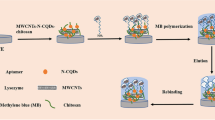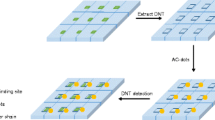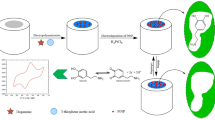Abstract
We report a molecularly imprinted polymer electrochemiluminescence (MIP-ECL) sensor with dual recognition effects on dopamine (DA). Boric-acid-functionalized carbon dots (B-CDs) with good ECL performance at − 2.0 V (vs. Ag/AgCl) were prepared and immobilized on a glassy carbon electrode (GCE). The MIP was then introduced via electropolymerization using o-phenylenediamine (OPD) as a functional monomer and DA as a template molecule to fabricate the MIP-ECL sensor. The cavities in the MIP after elution were used to capture the target molecular DA. The affinity of boric acid of B-CDs to the cis-diol of DA, as well as the special recognition of MIP, provides dual recognition effects on DA. The selective readsorption of DA onto the sensor leads to the ECL quenching of B-CDs. The quenching effect was used to detect DA from 1.0 × 10−9 to 1.0 × 10−5 mol·L−1 with a detection limit of 2.1 × 10−10 mol·L−1. The dual recognition caused the MIP-ECL sensor exhibiting excellent selectivity and sensitivity toward DA. The sensor was successfully used to determine DA in real samples.
Graphical abstract






Similar content being viewed by others
References
Jackowska K, Krysinski P (2013) New trends in the electrochemical sensing of dopa-mine. Anal Bioanal Chem 405(11):3753–3771. https://doi.org/10.1007/s00216-012-6578-2
Zhu L, Xu GH, Song Q, Tang T, Wang X, Wei FD, Hu Q (2016) Highly sensitive de-termination of dopamine by a turn-on fluorescent biosensor based on aptamer labeled carbon dots and nano-graphite. Sens Actuators B Chem 231:506–512. https://doi.org/10.1016/j.snb.2016.03.084
Li XQ, Liu XC, Liu YJ, Gao R, Wu X, Gao XB (2022) Highly sensitive detecti-on of dopamine based on gold nanoflowers enhanced-Tb(III) fluorescence. Talanta 249:123700. https://doi.org/10.1016/j.talanta.2022.123700
Wang YZ, Wang SQ, Huang MY, Chen FN (2020) Bifunctionalized prussian blue an-alogue particles oxidize luminol to produce chemiluminescence without other oxidants. Microchem J 158:105213. https://doi.org/10.1016/j.microc.2020.105213
Wu D, Xie H, Lu HF, Li W, Zhang QL (2016) Sensitive determination of norepinephrine, epinephrine, dopamine and 5-hydroxytryptamine by coupling HPLC with [Ag(HIO6)2]5−-luminol chemiluminescence detection. Biomed Chromatogr 30:1458–1466. https://doi.org/10.1002/bmc.3704
Liu H, Ding YN, Bian B, Li L, Li RM, Zhang XX, Liu ZX, Zhang X, Fan GC, Liu QY (2019) Rapid colorimetric determination of dopamine based on the inhibition of the p-eroxidase mimicking activity of platinum loaded cosn(OH)6 nanocubes. Microchim Acta 186(12):755. https://doi.org/10.1007/s00604-019-3940-5
Kiss L, David V, David IG, Lazăr P, Mihailciuc C, Stamatin I, Ciobanu A, Ştefănescu CD, Nagy L, Nagy G, Ciucu AA (2016) Electropolymerized molecular imprinting on glassy carbon electrode for voltammetric detection of dopamine in biological samples. Talanta 160:489–498. https://doi.org/10.1016/j.talanta.2016.07.024
Liu Y, Liu J, Liu J, Gan W, Ye BC, Li YC (2017) Highly sensitive and selective voltammetric determination of dopamine using a gold electrode modified with a molecularly imprinted polymeric film immobilized on flaked hollow nickel nanospheres. Microchim Acta 184(5):1285–1294. https://doi.org/10.1007/s00604-017-2124-4
Lu S, Hummel M, Chen K, Zhou Y, Kang S, Gu ZR (2020) Synthesis of Au@ZIF-8 nanocomposites for enhanced electrochemical detection of dopamine. Electrochem Commun 114:106715. https://doi.org/10.1016/j.elecom.2020.106715
Anshori I, Kepakisan KAA, Rizalputri LN, Althof RR, Nugroho AE, Siburian R, Handayani M (2022) Facile synthesis of graphene oxide/Fe3O4 nanocomposite for electrochemical sen-sing on determination of dopamine. Nanocomposites 8(1):155–166. https://doi.org/10.1080/20550324.2022.2090050
Fan XM, Sun N, Wang SM, Xu M, Zuo C, Xu XJ, Li ZJ, Sun QQ, Wang YM, Liu P, Fan XH (2022) A label-free electrochemiluminescence sensing for detection of dopamine based on TiO2 electrospun nanofibers. Electroanalysis 34(1):122–129. https://doi.org/10.1002/elan.202100502
Tang Y, Xu JT, Xiong CY, Xiao Y, Zhang XH, Wang SF (2019) Enhanced electroch-emiluminescence of gold nanoclusters via silver doping and their application for ultra-sensitive detection of dopamine. Analyst 144(8):2643–2648. https://doi.org/10.1039/c9an00032a
Wang YF, Guo WW, Jia NQ (2018) High-sensitivity electrochemiluminescence biosensor based on silver-carbon nitride for the detection of dopamine utilizing enhancement effects. ChemElectroChem 5(23):3786–3792. https://doi.org/10.1002/celc.201800877
Peng HP, Deng HH, Jian ML, Liu AL, Bai FQ, Lin XH, Chen W (2017) Electroc-hemiluminescence sensor based on methionine-modified gold nanoclusters for highly sensitive determination of dopamine released by cells. Microchim Acta 184(3):735–743. https://doi.org/10.1007/s00604-016-2058-2
Miao WJ (2008) Electrogenerated chemiluminescence and its biorelated applications. Chem Rev 108(7):2506–2553. https://doi.org/10.1021/cr068083a
Tan F, Cong LC, Li XN, Zhao Q, Zhao HX, Quan X, Chen JW (2016) An electrochemical sensor based on molecularly imprinted polypyrrole/graphene quantum dots composite for detection of bisphenol a in water samples. Sens Actuators B Chem 233:599–606. https://doi.org/10.1016/j.snb.2016.04.146
Li YC, Liu Y, Liu J, Tang H, Cao C, Zhao DS, Ding Y (2015) Molecularly imprinted polymer decorated nanoporous gold for highly selective and sensitive electrochemical sensors. Sci Rep 5(1):1–8. https://doi.org/10.1038/srep07699
Chen Y, Cao Y, Ma C, Zhu JJ (2020) Carbon-based dots for electrochemiluminescence sensing. Mater Chem Front 4(2):369–385. https://doi.org/10.1039/c9qm.00572b
Nesakumar N, Srinivasan S, Alwarappan S (2022) Graphene quantum dots: synthesis, properties, and applications to the development of optical and electrochemical sensors for chemical sensing. Microchim Acta 189(7):1–36. https://doi.org/10.1007/s00604-022-05353-y
Chen AY, Liang WB, Wang HJ, Zhuo Y, Chai YQ, Yuan R (2019) Anodic electroche-miluminescence of carbon dots promoted by nitrogen doping and application to rapid cancer cell detection. Anal Chem 92(1):1379–1385. https://doi.org/10.1021/acs.analchem.9b04537
Tang Y, Li JJ, Guo QF, Nie GM (2019) An ultrasensitive electrochemiluminescence a-ssay for Hg2+ through graphene quantum dots and poly(5-formylindole) nanocomposite. Sens Actuators B Chem 282:824–830. https://doi.org/10.1016/j.snb.2018.11.151
Dong YP, Peng Y, Wang J, Wang CM (2017) Determination of cytochrome C based on its enhancing effect on the electrogenerated chemiluminescence of carbon quantum dots. Microchim Acta 184(7):2089–2095. https://doi.org/10.1007/s00604-017-2217-0
Qin DM, Jiang XH, Mo GC, Zheng XF, Deng BY (2020) Electrochemiluminescence immunoassay of human chorionic gonadotropin using silver carbon quantum dots and functionalized polymer nanospheres. Microchim Acta 187(8):1–13. https://doi.org/10.1007/s00604-020-04450-0
Shen PF, Xia YS (2014) Synthesis-modifification integration: one-step fabrication of b-oronic acid functionalized carbon dots for fluorescent blood sugar sensing. Anal Chem 86(11):5323–5329. https://doi.org/10.1021/ac5001338
Xu SM, Che ST, Ma PY, Zhang FM, Xu LB, Liu X, Wang XH, Song DQ, Sun Y (2019) One-step fabrication of boronic-acid-functionalized carbon dots for the detection of sialic acid. Talanta 197:548–552. https://doi.org/10.1016/j.talanta.2019.01.074
Wang ZH, Qian YX, Wei XL, Zhang YF, Wu GF, Lu XQ (2017) An “on-off” electr-ochemiluminescence biosensor based on molecularly imprinted polymer and recycling amplifications for determination of dopamine. Electrochim Acta 250:309–319. https://doi.org/10.1016/j.electacta.2017.08.076
Li JP, Zhao J, Wei XP (2009) A sensitive and selective sensor for dopamine determination based on a molecularly imprinted electropolymer of o-aminophenol. Sens Actuators B Chem 140(2):663–669. https://doi.org/10.1016/j.snb.2009.04.067
Liu ZM, Zhang X, Ge XG, Hu LQ, Hu YJ (2019) Electrochemiluminescence sensing platform for ultrasensitive DNA analysis based on resonance energy transfer between graphitic carbon nitride quantum dots and gold nanoparticles. Sens Actuators B Chem 297:126790. https://doi.org/10.1016/j.snb.2019.126790
Zheng LY, Chi YW, Dong YQ, Lin JP, Wang BB (2009) Electrochemiluminescence of water-soluble carbon nanocrystals released electrochemically from graphite. J Am Chem Soc 131(13):4564–4565. https://doi.org/10.1021/ja809073f
Cui R, Gu YP, Bao L, Zhao JY, Qi BP, Zhang ZL, Xie ZX, Pang DW (2012) Near-infrared electrogenerated chemiluminescence of ultrasmall Ag2Se quantum dots for the detection of dopamine. Anal Chem 84(21):8932–8935. https://doi.org/10.1021/ac301835f
Zhou C, Chen Y, Shang P, Chi Y (2016) Strong electrochemiluminescent interactionsbetween carbon nitride nanosheet-reduced graphene oxide nanohybrids and folic acid, and ultrasensitive sensing for folic acid. Analyst 141(11):3379–3388. https://doi.org/10.1039/c6an00664g
Tezcan T, Hsu CH (2020) High-sensitivity SERS based sensing on the labeling side of glass slides using low branched gold nanoparticles prepared with surfactant-free synthesis. RSC Adv 10(56):34290–34298. https://doi.org/10.1039/d0ra02490b
You Y, Zou J, Li WJ, Chen J, Jiang XY, Yu JG (2022) Novel lanthanum vanadate-b-ased nanocomposite for simultaneously electrochemical detection of dopamine and uricacid in fetal bovine serum. Int J Biol Macromol 195:346–355. https://doi.org/10.1016/j.ijbiomac.2021.12.058
He WY, Ding Y, Zhang WQ, Ji LF, Zhang X, Yang FC (2016) A highly sensitive se-nsor for simultaneous determination of ascorbic acid, dopamine and uric acid based on ultra-small Ni nanoparticles. J Electroanal Chem 775:205–211. https://doi.org/10.1016/j.jelechem.2016.06.-001
Acknowledgements
We thank LetPub (www.letpub.com) for its linguistic assistance during the preparation of this manuscript.
Author information
Authors and Affiliations
Corresponding author
Ethics declarations
Competing interests
The authors declare no competing interests.
Additional information
Publisher's note
Springer Nature remains neutral with regard to jurisdictional claims in published maps and institutional affiliations.
Supplementary Information
Below is the link to the electronic supplementary material.
Rights and permissions
Springer Nature or its licensor holds exclusive rights to this article under a publishing agreement with the author(s) or other rightsholder(s); author self-archiving of the accepted manuscript version of this article is solely governed by the terms of such publishing agreement and applicable law.
About this article
Cite this article
Zhang, T., Long, D., Gu, X. et al. A dual-recognition MIP-ECL sensor based on boric acid functional carbon dots for detection of dopamine. Microchim Acta 189, 389 (2022). https://doi.org/10.1007/s00604-022-05483-3
Received:
Accepted:
Published:
DOI: https://doi.org/10.1007/s00604-022-05483-3




